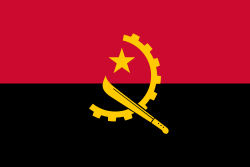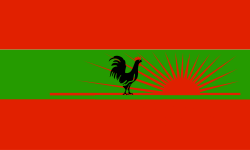National flag
| Flag | Date | Use | Description |
|---|---|---|---|
 | 1975–present |
This is a list of flags associated with Angola.
| Flag | Date | Use | Description |
|---|---|---|---|
 | 1975–present |
| Flag | Date | Use | Description |
|---|---|---|---|
current | |||
 | ?–present | Standard of the President of Angola | |
former | |||
 | ?–1975 | Flag of Governor of Portuguese Angola | |
 | ?–1975 | ||
 | 1510s–c. 1543 | ||
| Flag | Date | Use | Description |
|---|---|---|---|
current | |||
 | ?–present | Flag of the Angola National Police pt | |
| Flag | Date | Use | Description |
|---|---|---|---|
current | |||
 | ?–present | Flag of the Angola Penitentiary Service | |
| Flag | Date | Use | Description |
|---|---|---|---|
current | |||
 | 1979–present | Flag of the Angolan Olympic Committee | |
| Flag | Date | Regime | Description |
|---|---|---|---|
| 1482–1485 | Flag of the Kingdom of Portugal | ||
| 1485–1495 | Flag of the Kingdom of Portugal | ||
| 1495–1521 | Flag of the Kingdom of Portugal | ||
| 1521–1578 | Flag of the Kingdom of Portugal | ||
| 1578–1640 | Flag of the Kingdom of Portugal | ||
 | c. 17th century | Flag of the Kingdom of Kongo according to Giovanni Cavazzi da Montecuccolo | |
 | c. 17th century | Flag of the Kingdom of Ndongo according to Giovanni Cavazzi da Montecuccolo | |
 | |||
| 1616–1640 | Flag of the Kingdom of Portugal (Putative) | ||
| 1640–1667 | Flag of the Kingdom of Portugal | ||
| 1641–1648 | The Prince's Flag in the Dutch Republic | ||
| 1667–1706 | Flag of the Kingdom of Portugal | ||
| 1706–1750 | Flag of the Kingdom of Portugal | ||
| 1826–1834 | |||
| 1750–1816 | Flag of the Kingdom of Portugal | ||
| 1816–1826 | Flag of the Kingdom of Portugal | ||
| 1834–1910 | Flag of the Kingdom of Portugal | ||
 | c. 1883 | Royal Banner of the Kingdom of Kakongo | |
| Flag | Date | Use | Origin | Description |
|---|---|---|---|---|
 | 2003 | Proposed flag of Angola | From "Catica", the submission 106 was chosen by the Constitutional Commission to be the new flag, but was never implemented. | Five horizontal stripes: the top and bottom stripes are blue, separated by thin white stripes, with a broad red stripe in the middle. Centered on the red stripe is a yellow sun. The sun design in the middle is meant to be reminiscent of cave paintings found in Tchitundo-Hulu cave near Virei. |
 | 1965 | Proposed flag of the Portuguese overseas province of Angola | From heraldist Franz Paul de Almeira Langhans in his book "Armorial do Ultramar Português". | The Flag of Portugal defaced with the colony's lesser arms shield on its lower fly side. |
 | 1932 | Proposed flag of the Colony of Angola | From the Portuguese Institute of Heraldry (IPH), by Affonso Dornellas and João Ricardo da Silva, to the Agência Geral das Colónias (General Agency of the Colonies). [3] | The flag is divided into four purple and yellow triangular sections radiating from the center. In the center of the flag is a shield with a golden pelican feeding its young in a purple field. The golden border of the shield contains five small blue shields with white dots and four red crosses of the Order of Christ. Above the shield is a mural crown and below the shield is a white scroll with the word "ANGOLA" written on it. |
| Flag | Date | Party | Description |
|---|---|---|---|
current | |||
 | 2020–present | Party logo on a white background. | |
 | 2012–present | Blue map of Angola surrounded by 18 white stars on a green background. Angola is divided into 18 provinces. | |
 | 2006–present | White ring on an orange background. | |
 | 1991–present | Vertical red white green tricolor. In the middle band is a yellow disc held by two symmetrical black hands. | |
| Link to file | 1990–present | A blue flag with the party logo, the logo consists of a handshake on a red disc background. | |
 | 1990–present | Two horizontal bands of red and green with a black vertical band on the hoist side and white disc where the colors meet. | |
 | 1966–present | A horizontal triband consisting of a white central band sandwiched between two red bands. It is charged in the center with a black silhouette of a crowing rooster and on the right with a red silhouette of a rising sun with 16 rays. Red represents the blood shed by Angolans in anti-colonial actions before the war of independence, while green represents hope and faith in victory. The rooster symbolises "a call upon the peoples of Africa to become aware of the foreign nomination of Africa". The rising sun represents the start of the war of independence and the unity of Angola's 16 provinces in the war. [4] | |
 | |||
 | 1960–present | A horizontal bicolour consisting of a red upper band and a black lower band, charged in the center with a yellow five-pointed star. The symbolism of the colours is the same as that of the Angolan flag. [5] American vexillologist Whitney Smith suggests that the design may have been derived from the flag of the Viet Cong, from which the MPLA adopted strategies and principles. [6] | |
 | 1954–present | A diagonal tricolour of white, red and yellow radiating from the lower hoist side corner, and white star in the center. | |
Youth wings | |||
 | 1974–present | Emblem on a red background. | |
 | 1962–present | A horizontal tricolour of red, blue and black with yellow rising sun on the middle stripe. | |
former | |||
 | 1994–2013 | ||
 | |||
| Link to file | 1992–2013 | White flag with a rose flower with a stem. | |
 | 1990s–2013 | Horizontal bicolor green and black field. Centered on the flag is a yellow disc, upon which is placed a white five-pointed star. On the star there is a white dove in flight. | |
 | 1990s | A horizontal tricolour of blue, white and green. | |
 | 1988–2013 | ||
 | 1983–2013 | ||
| Flag | Date | Party | Description |
|---|---|---|---|
 | c. 1975–present | ||
1990s–present | |||
 | 1996–present | Horizontal blue, copper and black tricolour, the symbol in the middle is a padrão commemorating the Treaty of Simulambuco. [7] | |
?–present |
| Flag | Date | Use | Description |
|---|---|---|---|
 | Flag of the Lunda-Tchokwé people | ||
 | Flag of the Kongo people | ||
 | Flags of the Mbunda Kingdom | A white flag with a drawing of an African elephant. | |
 |
| Flag | Date | Use | Description |
|---|---|---|---|
 | 1978–present | Flag of the Angola Red Cross | Red Cross surrounded by the association's name. |
| Burgee | Club |
|---|---|
 |